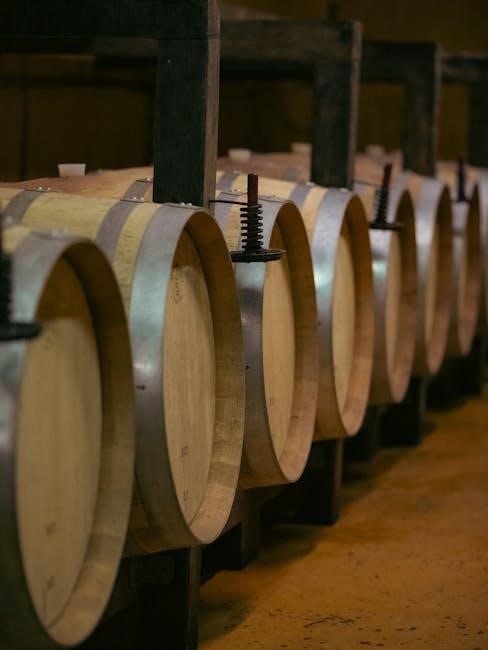Edgar Allan Poe’s “The Cask of Amontillado” is a chilling tale of revenge and betrayal, first published in 1846. Set during an Italian carnival, it explores dark themes through a haunting narrative.
Background and Publication History
Edgar Allan Poe’s “The Cask of Amontillado” was first published in the November 1846 issue of Godey’s Lady’s Book. This short story falls under the horror fiction category and revolves around themes of revenge and betrayal. The tale is part of Poe’s “shadow tales,” which explore morally ambiguous acts without clear moral judgment. The story is now in the public domain, with free PDF versions available from sources like Ryerson University and the Pennsylvania State University’s Electronic Classics Series. These versions are free of copyright restrictions, making the story accessible to readers worldwide. The PDF format preserves the original narrative’s chilling tone and intricate details, ensuring its haunting legacy endures in modern times.
Themes and Motifs in the Story
Central themes in “The Cask of Amontillado” include revenge, betrayal, and the psychological depths of human darkness. Poe explores the idea of revenge as a calculated act, devoid of remorse, highlighting the narrator’s meticulous planning. Betrayal is evident in Montresor’s deceptive friendship with Fortunato, luring him to his doom. The story also delves into guilt and the irony of fate, as Montresor’s actions lead to irreversible consequences. The catacombs symbolize entrapment and death, while the trowel and motto emphasize the narrator’s pride and commitment to his dark mission. These elements weave a tale of moral ambiguity, leaving readers to ponder the nature of evil and justice.

Plot Summary
During an Italian carnival, Montresor lures his rival Fortunato into the catacombs with promises of rare Amontillado wine, leading to a tragic and deadly act of revenge.
Setting of the Story
The story unfolds during the carnival season in an unnamed Italian city, creating a festive yet eerie backdrop. The primary setting is the dark, damp catacombs beneath Montresor’s family estate, filled with ancient bones and a haunting atmosphere. The underground tunnels symbolize isolation and entombment, contrasting sharply with the lively carnival above. The time period is not explicitly stated but is inferred to be the 19th century, aligning with Poe’s writing era. The catacombs’ gothic setting amplifies the story’s horror elements, while the carnival’s revelry highlights the irony of Fortunato’s tragic fate. This duality of settings underscores the themes of revenge and deception.
Main Characters
The story revolves around two central figures: Montresor and Fortunato. Montresor, the narrator, is a nobleman driven by a deep-seated desire for revenge against Fortunato, whom he perceives has wronged him. His calculating and methodical nature is evident as he meticulously plans and executes his vengeance. Fortunato, a fellow nobleman and connoisseur of fine wines, is lured into Montresor’s trap due to his pride and naivety. His enthusiasm for the Amontillado wine blinds him to the danger, making him an unsuspecting victim. The unnamed narrator, often interpreted as Montresor himself, adds depth to the story by providing insight into the darker aspects of human psychology. Their complex dynamics drive the tale’s tragic conclusion.
Detailed Plot Breakdown
The story unfolds during the carnival season in an unnamed Italian city. Montresor, the narrator, seeks revenge against Fortunato, whom he believes has insulted him. Montresor lures Fortunato into his family catacombs with the promise of a rare bottle of Amontillado wine. As they descend deeper into the tunnels, Montresor’s true intentions become clear. He chains Fortunato to a wall and begins sealing the entrance with bricks. Fortunato, realizing his fate too late, screams for help, but his cries are muffled by the festivities above. Montresor completes the entombment, leaving Fortunato to die a slow, terrifying death. The story ends with Montresor’s chilling statement, “In pace requiescat!”
Major Themes

The story explores themes of revenge, betrayal, guilt, and the irony of fate, delving into the darker aspects of human nature and morality.
Revenge and Retribution
Revenge is the central theme of “The Cask of Amontillado.” Montresor, driven by a deep-seated desire for retribution, meticulously plans and executes his vengeance against Fortunato. The story highlights the destructive nature of unchecked revenge, as Montresor’s actions are motivated by a perceived insult to his family’s honor. His methodical approach, devoid of empathy, underscores the chilling efficiency of his plan. The tale serves as a cautionary exploration of how obsession with revenge can lead to moral decay and irreversible consequences. Through Montresor’s narrative, Poe examines the psychological depths of revenge, revealing its devastating impact on both the perpetrator and the victim.
Betrayal and Deception
Betrayal and deception are central to the narrative of “The Cask of Amontillado.” Montresor’s calculated manipulation of Fortunato, disguised as friendship, exemplifies the theme. He lures Fortunato into the catacombs with the promise of rare Amontillado wine, exploiting his victim’s pride and vanity. The irony lies in Fortunato’s enthusiasm for his own demise, unaware of the betrayal. Montresor’s deceptive charm and meticulous planning highlight the darkness of human nature, as he hides his true intentions behind a mask of camaraderie. This betrayal is not just physical but psychological, as Montresor seeks to destroy Fortunato’s dignity and pride. Poe masterfully explores how deception can lead to devastating consequences, leaving a lasting impact on the reader.

Guilt and Remorse
Guilt and remorse are notably absent in Montresor, the narrator of “The Cask of Amontillado.” His meticulous planning and execution of revenge reveal a lack of conscience, as he feels no regret for his actions. Even in recounting the tale, Montresor shows no signs of remorse, highlighting his moral ambiguity. Fortunato, on the other hand, is oblivious to the betrayal until it is too late, leaving no room for guilt. The story’s chilling aspect lies in its exploration of a psyche untouched by guilt, emphasizing the darkness of human nature. Poe’s portrayal of such emotions, or their absence, adds depth to the narrative, leaving readers to ponder the moral implications of such actions.
The Irony of Fate
The irony of fate is a pervasive element in “The Cask of Amontillado,” underscored by the tragic inevitability of Fortunato’s demise. The story’s title itself hints at the doomed cask of wine, symbolizing the entrapment of both characters. Fortunato, whose name ironically means “the fortunate,” meets a horribly unfortunate end. Montresor’s trowel, a tool of his trade, becomes the instrument of his revenge, adding layers of irony to his meticulous planning. The Montresor family motto, “Nemo me impune lacessit” (“No one provokes me with impunity”), further emphasizes the fateful consequences of Fortunato’s actions. Poe masterfully weaves these ironies to create a sense of inescapable doom, highlighting the dark humor and tragic fate that define the narrative.

Character Analysis
Montresor, the calculating narrator, seeks revenge with chilling precision, while Fortunato, a proud wine connoisseur, falls victim to his own hubris and Montresor’s deceitful trap.
Montresor: The Narrator

Montresor, the narrator, is a man consumed by a desire for revenge against Fortunato. He is calculating and meticulous, planning every detail of his vengeance to ensure it is both flawless and irreversible. His motivation stems from a perceived insult to his family’s honor, which he cannot tolerate. Montresor’s character is defined by his cold rationality and lack of remorse, showcasing Poe’s exploration of psychopathy. Throughout the story, Montresor’s narration reveals his manipulative nature, as he lures Fortunato into the catacombs with the promise of Amontillado wine. His actions are driven by a twisted sense of justice, making him one of literature’s most chilling antagonists.
Fortunato: The Victim
Fortunato, a fellow nobleman and connoisseur of fine wines, is the unfortunate victim of Montresor’s revenge. His pride and arrogance make him vulnerable to Montresor’s manipulations. Fortunato’s enthusiasm for the Amontillado wine blinds him to the danger, leading him deeper into the catacombs. His character is marked by overconfidence and a lack of awareness, which ultimately seals his fate. The irony of his name, meaning “the fortunate one,” contrasts sharply with his tragic end. Fortunato’s demise serves as a grim reminder of the consequences of unchecked pride and the devastating power of revenge.
The Unnamed Narrator
The unnamed narrator in “The Cask of Amontillado” is a psychopathic figure who meticulously plans and executes his revenge against Fortunato. His narrative voice is calm, calculated, and devoid of remorse, reflecting Poe’s exploration of the darker aspects of human psychology. The narrator’s lack of emotional depth and his rationalization of the crime highlight the theme of moral ambiguity. His identity remains a mystery, adding to the story’s enigmatic nature. The narrator’s perspective immerses readers in his twisted mindset, creating a chilling atmosphere. His presence underscores the story’s central themes of revenge, betrayal, and the blurred lines between good and evil, leaving a lasting impact on the reader.
Symbols and Imagery
The story is rich in symbolic elements, with the cask of Amontillado representing deception and temptation. The catacombs symbolize death and entrapment, while the trowel signifies both construction and destruction. The Montresor family motto, “Nemo me impune lacessit” (“No one provokes me with impunity”), underscores the theme of revenge, tying together the narrative’s dark and ominous imagery.
The Cask of Amontillado
The cask of Amontillado is a central symbol in Poe’s tale, representing deception and temptation. Montresor uses it to lure Fortunato, exploiting his pride and obsession with fine wines. The rare Amontillado wine symbolizes exclusivity and desire, drawing Fortunato into a deadly trap. The cask itself is a tool of manipulation, highlighting Montresor’s cunning and the theme of revenge. Its presence in the catacombs underscores the story’s dark irony, as the promise of a prized wine leads to entombment. The cask serves as a metaphor for the fatal allure of vanity and the consequences of unchecked ambition, tying together the narrative’s themes of betrayal and retribution.
The Catacombs
The catacombs in Edgar Allan Poe’s “The Cask of Amontillado” serve as a chilling and symbolic setting. They are damp, nitre-covered tunnels beneath Montresor’s family palace, used for burial and storage. The catacombs represent a place of confinement, death, and eternal silence. Montresor lures Fortunato into this subterranean labyrinth under the pretext of tasting the Amontillado, leading him deeper into the darkness. The catacombs’ eerie atmosphere heightens the sense of doom and isolation, emphasizing the horror of Fortunato’s entombment. Their cold, unyielding walls mirror Montresor’s unrelenting pursuit of revenge, while their historical significance underscores the story’s themes of burial and irreversible fate. The catacombs are both a physical and symbolic trap, sealing Fortunato’s destiny.
The Trowel
The trowel in Edgar Allan Poe’s “The Cask of Amontillado” is a significant object that symbolizes both Montresor’s meticulous planning and the story’s dark irony. Montresor, a master stonemason, uses the trowel to construct the brick wall that entombs Fortunato. The trowel represents his skill and precision, as well as his cold, calculating nature. It also serves as a tool of deception, as Montresor carries it openly, further convincing Fortunato of his genuine intentions. The trowel’s presence underscores the inevitability of Fortunato’s fate, as it is the instrument that seals his doom. Its practical use contrasts with the horror of the act, highlighting the chilling efficiency of Montresor’s revenge. The trowel becomes a haunting symbol of irreversible consequences and the finality of death.
The Motto

The Montresor family motto, “Nemo me impune lacessit” (“No one provokes me with impunity”), is a central symbol in “The Cask of Amontillado.” This Latin phrase, emblazoned on the family crest, reflects Montresor’s pride and his relentless pursuit of revenge. The motto underscores his belief in the inevitability of retribution for any perceived slight, driving his actions against Fortunato. It also highlights the story’s themes of honor, vengeance, and the unyielding nature of Montresor’s character. The motto serves as a chilling reminder of the consequences of crossing the Montresor family, embodying the dark, unrelenting spirit of the narrative. Its presence ties the story’s events to a broader legacy of pride and vengeance.

Literary Devices
Poe employs irony, foreshadowing, and a haunting point of view to create tension and psychological depth, immersing readers in Montresor’s vengeful mindset and the story’s dark, tragic unfolding.
Irony
In “The Cask of Amontillado,” Poe masterfully uses irony to heighten tension and underscore the dark themes. Verbal irony is evident in Montresor’s courteous yet sinister dialogue, such as his repeated “In pace requiescat,” which contrasts with his murderous intent. Situational irony is prominent in Fortunato’s fate—he is lured to his death by the promise of a rare wine, Amontillado, which he never tastes. The story’s setting, an Italian carnival, adds layers of irony, as the festive atmosphere juxtaposes the grim events unfolding in the catacombs. Poe’s use of irony creates a haunting and tragic tone, emphasizing the inevitability of Fortunato’s doom and the moral ambiguity of Montresor’s revenge.
Foreshadowing
Foreshadowing is a critical literary device in “The Cask of Amontillado,” as Poe skillfully hints at the story’s tragic outcome. The setting of the damp, eerie catacombs immediately suggests death and entombment. Montresor’s trowel, introduced early, foreshadows its use in sealing Fortunato’s fate. The coat of arms on Montresor’s ring—a skull and crossed bones—symbolizes mortality and revenge. Fortunato’s cough and his toast to the “dead” also subtly foreshadow his impending doom. Montresor’s repeated references to his family motto, “In pace requiescat,” further hint at the eternal rest Fortunato will soon endure. These subtle clues build tension and prepare readers for the horrifying conclusion, showcasing Poe’s mastery of suspense and dramatic irony.
Point of View
The story is narrated by Montresor, offering a first-person perspective that immerses readers in his twisted mindset. This narrative choice creates a sense of intimacy and immediacy, allowing readers to experience Montresor’s motivations and emotions firsthand. However, Montresor’s reliability as a narrator is questionable, as his obsession with revenge clouds his judgment. The use of first-person narration also heightens the psychological tension, forcing readers to confront the darker aspects of human nature. Additionally, the unnamed narrator in the PDF version provides an objective counterpoint, contrasting with Montresor’s biased account and emphasizing the moral ambiguity of the tale. This dual perspective underscores the themes of revenge and betrayal, leaving readers to grapple with the story’s unsettling implications.

Reception and Legacy
“The Cask of Amontillado” is a classic tale of horror, widely acclaimed for its psychological depth and exploration of revenge. Its PDF version remains popular, ensuring Poe’s legacy endures.
Initial Reception
When first published in the November 1846 issue of Godey’s Lady’s Book, “The Cask of Amontillado” sparked mixed reactions. Some readers were shocked by its macabre themes, while others praised its psychological complexity. Critics noted its masterful use of suspense and dark irony, though a few deemed it too unsettling. The story’s exploration of revenge and betrayal resonated deeply, solidifying Poe’s reputation as a master of horror. Its availability in PDF format today ensures its enduring accessibility, allowing modern readers to experience the chilling tale that captivated 19th-century audiences.
Modern Interpretations

Modern readers and scholars continue to dissect “The Cask of Amontillado” for its psychological depth and moral ambiguity. The story’s exploration of revenge, devoid of clear moral judgment, fascinates contemporary audiences. Many interpret it as a reflection of Poe’s fascination with the darker aspects of human nature. Feminist and psychoanalytic critics explore themes of power dynamics and repressed emotions. The PDF version’s widespread availability has made it easier for students and enthusiasts to analyze the tale’s intricate layers. Its enduring relevance lies in its ability to provoke thought about justice, morality, and the blurred lines between good and evil, ensuring its place in modern literary discourse.
Cultural Impact
Edgar Allan Poe’s “The Cask of Amontillado” has left an indelible mark on literature and popular culture. Its themes of revenge and betrayal continue to captivate audiences, inspiring adaptations in film, theater, and art. The story’s chilling narrative has influenced horror genres, making it a cornerstone of dark storytelling. Its availability in PDF format has ensured its accessibility, allowing new generations to engage with Poe’s work. The tale’s exploration of psychological complexity resonates globally, reflecting universal human emotions. Additionally, collaborations like Alan Cumming’s reading on the Calm app highlight its enduring appeal. Its cultural impact is further evident in its use in educational resources, fostering critical thinking and literary analysis. The story’s public domain status has cemented its place in cultural heritage, ensuring its continued relevance and influence.
PDF Version and Availability
The Cask of Amontillado is freely available as a PDF, created by José Menéndez, and can be downloaded from public domain sources like Archive.org.
Downloading the PDF
The PDF version of Edgar Allan Poe’s The Cask of Amontillado is widely available for free download from public domain sources like Archive.org and other digital libraries. Users can access the story in EPUB and PDF formats, compatible with devices such as Kindles, tablets, and PCs. The story is part of the Electronic Classics Series by Pennsylvania State University, ensuring a reliable and high-quality digital version. Many platforms offer direct links for downloading, making it easily accessible to readers worldwide. The PDF is free of copyright restrictions, allowing unrestricted sharing and reading. This convenience ensures that Poe’s classic tale remains accessible to modern audiences, preserving its legacy for future generations.
Features of the PDF Version
The PDF version of Edgar Allan Poe’s The Cask of Amontillado offers a convenient and high-quality reading experience. It is free to download from platforms like Archive.org and other public domain sources. The PDF is part of the Electronic Classics Series by Pennsylvania State University, ensuring a well-formatted and professional layout. Compatible with various devices, including Kindles, tablets, and PCs, the file preserves the original text’s integrity. Many versions include study guides, summaries, and analysis, enhancing reader understanding. The PDF is free of copyright restrictions, making it easily shareable. Its portability and clarity ensure that Poe’s masterpiece remains accessible and engaging for modern readers, maintaining its eerie and thought-provoking appeal.

Leave a Reply
You must be logged in to post a comment.